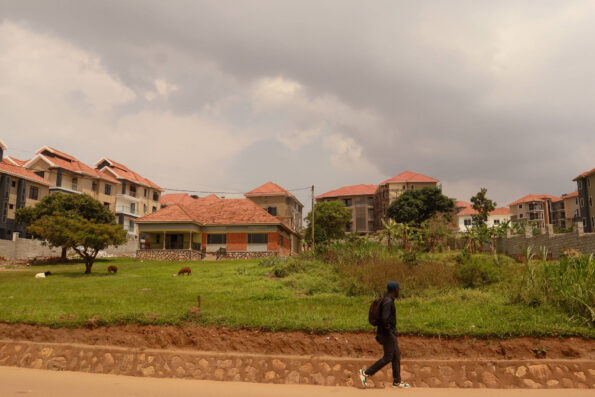
NAIROBI, KENYA – It’s a normal Saturday evening in Nairobi. Laughter and happy chatter fill the warm air. But it is soon disrupted by a scream of agony and pain.
“Someone help me,” a woman cries out in Swahili.
Crowds begin to throng outside the gated office building where the woman is sprawled on the sidewalk. Her hair is unkempt, clothes tattered, and face stained with dust, grime, saliva and tears. She reeks of alcohol.
She waves what looks like an ultrasound report. Her screams grow louder each time, and she raises her skirt as if she’s about to give birth.
Five women rush to assist her. One woman calls an ambulance as another, with no surgical gloves available, wraps her hands in plastic bags to help the woman deliver. She prods the woman to push. The street woman screams and says the baby is coming. She pushes once more then falls silent as her legs cave to the ground.
Responding to the commotion, the security personnel of the building call the Nairobi City Council to report a public disturbance. One bystander runs to a nearby office building to call a doctor, as the ambulance still hasn’t arrived.
The doctor, Dr. Omondi Kwaye, arrives with his surgical gloves and receives a quick rundown of the events of the past 10 minutes. He asks the woman her name. She says Mercy Achieng’.
Achieng’ reaches feebly toward a yellow folder with her name on it and the ultrasound report. The doctor flips through them then asks her to raise her legs once again.
This time, he pushes back what crowds thought was a baby. Achieng’ lets out a bloodcurdling scream. The doctor tells the team of Good Samaritans who had rushed to her aid that it was her uterus – not a baby – that was coming out of her body.
A prolapsed uterus is when the uterus falls from its normal position in the pelvic cavity to the vaginal canal.
The city council personnel arrive in a dilapidated vehicle ready to whisk Achieng’ away to jail for causing a public disturbance, as one woman pleads with them not to take her and calls the ambulance service persistently. It has been 20 minutes since the first call, but the ambulance has not yet arrived.
Despite calls from Kenya’s ministers and an international pledge to increase the percentage of the budget allocated to the health sector, the government reduced it in the current budget. Doctors say that universal health care and local networks are the solution to increasing access to the millions of Kenyans without health insurance. Kenyans say that high costs and low quality currently deter them most. Others say a welfare system is the only way to achieve health care for all.
As in many developing countries, universal medical care in Kenya is still in the debate stage. The Kenyan government has allocated just 6.5 percent of the 2010-2011 national budget of 1 trillion shillings, $12.5 billion USD, the largest budget in the country’s history, to the health sector. Although this almost doubled the health budget, it is a drop in percentage from the previous year’s allocation of 7 percent of the budget of 512.7 billion shillings, $6.1 billion USD, according to a budget analysis by the Kenyan-German Development Cooperation, a joint government development agency.
About 2 million of Kenya’s 40 million residents have public health insurance under the National Hospital Insurance Fund, which relies on contributions from high-earning Kenyans to cover hospital benefits for members and their dependents, according to a 2009 report by the United States Agency for International Development, a government agency that provides economic and humanitarian assistance worldwide. And just 2 percent of the population can afford private health insurance, which some say is needed to receive care at certain hospitals and health facilities.
The need to increase the budgetary allocation to the health sector in Kenya has received increased government attention this year.
Minister of Medical Services Peter Anyang’ Nyong’o, who recently returned from receiving treatment for prostate cancer in the United States because it wasn’t available in Kenya, says that universal health care is the only way to guarantee Kenyans medical care. His counterpart, Minister of Public Health Beth Mugo, urged the country’s treasury in March to increase health funding to 15 percent of the national budget, as the state pledged to do back in 2001.
In 2001, the heads of state of the African Union countries met in Abuja, Nigeria, and pledged to allocate at least 15 percent of their national budgets to the health sector in the Abuja Declaration.
A decade later, only two African countries, South Africa and Rwanda, have managed to reach this goal, according to the World Health Organization, WHO. Twenty-seven African countries have increased their expenditure on health care, but 12 countries – including Kenya – have kept theirs the same and seven African countries have reduced theirs.
Dr. Sam Gwer, a pediatrician with Afya Research Africa, an international nongovernmental organization dedicated to health care research and policy, says the solution must originate within the government.
“Universal health care needs to start with interministerial solutions,’’ Gwer says.
Gwer’s colleague, Dr. Moses Nderitu, an epidemiologist, says that a prerequisite for universal health care is a network of local health care systems that would make health care more accessible to people in remote and rural areas. This way, people would have access to doctors, equipment and medication in their districts and regions instead of having to travel far distances to receive care as they do now.
“[This] will provide a pool of patient records and a system to monitor disease and infection rates in regions to provide solutions,” Nderitu says.
Both doctors also identified a need for greater interaction between Kenyans and public health officers to define the priority health concerns. They also expressed the need for a culture of research at local levels.
Afya Research Africa is currently working with Thika Hospital and Kenyatta University, both in Nairobi, to set up district surveillance systems.
“[The system] will assist the doctors to understand the various diseases prevalent in the area [and] track and address the causes of diseases rather than just dispense medication,” Gwer says.
Gwer says that the causes of diseases in Kenya revolve around four key areas: sanitation caused by inaccessibility to clean water; ignorance about reproductive health; deficiency because of drought and famine; and trauma from road traffic accidents.
He says that economic empowerment, which would reduce disease and, therefore, the need for care, is the key to achieving universal health care. He says Kenya should learn from the United Kingdom, UK, which solved a diarrhea outbreak in the early 20th century by improving the national standard of living.
“The greatest intervention of public health at that time in the UK was access to clean drinking water,” he says.
He says the UK employed a similar strategy to resolve its increasing tuberculosis infection rate then, too.
“The government focused on boosting the economic standing of its citizenry, better housing, which reduced overcrowding,’’ he says.
Gwer and Nderitu say that doing research and demystifying it for the general population is the beginning of providing a cure to recurrent diseases plaguing various communities across Kenya.
Zablon Tirimba, a recent university graduate, says he doesn’t have health insurance and that the main problem is access.
“I find health care relatively affordable when you are in the city,” he says.
He says this is because well-equipped hospitals are mainly based in cities. But he says there are few in suburban and rural areas.
“That in itself adds to the expense of health care,” he says.
He says that public hospitals must also improve the quality and speed of their service and that the government should communicate better with citizens about health care.
“Get the voice of the people,” he says.
Mwikali Ndambo, a professional in the food industry who also doesn’t have insurance, says that the government should encourage competition in the private health sector in order to lower costs and increase the quality of care.
“When people have choice and they know they have choice, they won’t just go for what’s being thrown at them, forcing providers to actually think about their product, services and costs in order to attract and retain customers,” she says. “The fewer the players in the health insurance field, the less the choice and the less the need to really concern themselves with clients.”
Susan Wasaba, a customer service executive without health insurance, says health care is too expensive.
“The Kenyan health system is for the well-to-do,” Wasaba says.
Kwaye says that the only way to achieve effective and universal medical care is through a functional welfare system.
“The welfare system will involve the private sector identifying and pooling resources together to administer health care at negligible cost to improve the quality of life for those who need it most,’’ he says.
Until then, Kenyans like Achieng’ will continue to go without the medical attention they need.
After being rushed to Kenyatta National Hospital when the ambulance arrived 45 minutes after the first call, she was discharged the following day. It is not clear whether any medication was given to her or where she is now.
Kwaye says that a prolapsed uterus is not an emergency condition.
“The patient’s discharge the next day was expected,” he says.
But he says that it may become infected or collapse again without the proper care.
“The surgical management she needs requires extensive evaluation of the patient,” he says. “She needs to be checked into a hospital [and] seen by a gynecologist, tests run and surgery planned.”
But since Achieng’ doesn’t have a cent for medical treatment, she is forced to live with her condition at the risk of further infection and another collapse.
“Anytime she strains her body, whether it’s a cough, passing stool or urine or lifting something heavy, there is a likelihood that her uterus may collapse again,” Kwaye says. “Constantly pushing back the uterus [in leaves] her susceptible to more infections.”







